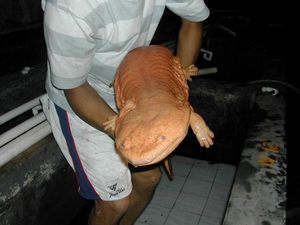Humans are eating big animals to extinction, scientists claim
Many ‘megafauna’ species are threatened by ‘human consumption of meat or body parts’, according to researchers.

Large animals are being “eaten to extinction” by humans, say scientists.
Researchers studied nearly 300 species of “megafauna” that included mammals, fish, birds, amphibians and reptiles.
Over the past 500 years, 2% of megafauna species had vanished from the Earth as humans refined their ability to kill from a safe distance, said the scientists.
Nine species had become extinct either globally or in the wild in the past 250 years, including two kinds of giant tortoise, one of which disappeared in 2012.
Overall, 70% of the species studied were in decline and 59% facing extinction.
The main threat to the animals was human demand for their meat or body parts, said the team writing in the journal Conservation Letters.
Lead scientist Professor William Ripple, from Oregon State University in the US, said: “Direct harvest for human consumption of meat or body parts is the biggest danger to nearly all of the large species with threat data available.
“Our results suggest we’re in the process of eating megafauna to extinction.”
The team adopted a definition of megafauna based on different weight thresholds for mammals, fish, amphibians, birds and reptiles.
Species that were unusually large when compared with others from the same animal family were included in the list.
One example of a highly threatened species was the Chinese giant salamander, which can grow up to 6ft long and is considered a delicacy in Asia.
Its extinction in the wild was now imminent, said the scientists.
Prof Ripple added: “In addition to intentional harvesting, a lot of land animals get accidentally caught in snares and traps, and the same is true of gillnets, trawls and longlines in aquatic systems.
“And there’s also habitat degradation to contend with.
“When taken together, these threats can have major negative cumulative effects on vertebrate species.”





